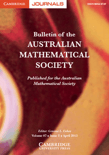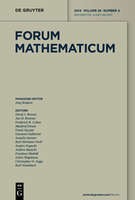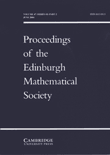
BULLETIN OF THE AUSTRALIAN MATHEMATICAL SOCIETY
Scope & Guideline
Empowering the Mathematical Community Through Knowledge
Introduction
Aims and Scopes
- Algebra and Number Theory:
This area includes research on algebraic structures, group theory, number theory, and modular forms, contributing to the understanding of fundamental mathematical concepts. - Graph Theory and Combinatorics:
The journal features studies on graph properties, combinatorial designs, and extremal combinatorics, which are essential for both theoretical developments and practical applications. - Analysis and Differential Equations:
Publications in this scope involve real and complex analysis, functional analysis, and the study of differential equations, focusing on both classical and modern techniques. - Topology and Geometry:
Research articles explore topological spaces, geometric structures, and their interrelations, contributing to the foundational aspects of mathematical theory. - Applied Mathematics and Computational Methods:
The journal also includes applied mathematics, particularly in areas such as numerical analysis, mathematical modeling, and simulations, bridging theory and practical application. - Probability and Statistics:
Contributions in this area cover stochastic processes, statistical methods, and their applications in various fields, reflecting the growing importance of probabilistic approaches in mathematics.
Trending and Emerging
- Interdisciplinary Applications:
There is a growing trend towards interdisciplinary approaches that apply mathematical concepts to fields such as biology, economics, and engineering, reflecting the increasing relevance of mathematics in real-world problems. - Computational Mathematics:
Research focusing on numerical methods, simulations, and algorithm development is on the rise, highlighting the importance of computational tools in solving complex mathematical problems. - Algebraic Geometry and Commutative Algebra:
There is an increasing interest in algebraic geometry and its connections to commutative algebra, with more papers exploring geometric properties and algebraic structures. - Probabilistic Methods in Combinatorics:
The use of probabilistic techniques in combinatorial problems is becoming more prominent, indicating a trend towards innovative methodologies in addressing classical combinatorial challenges. - Mathematical Modelling and Optimization:
Research articles focusing on mathematical modeling and optimization techniques are emerging more frequently, underscoring the practical applications of mathematical theory in various industries.
Declining or Waning
- Classical Geometry:
There has been a noticeable reduction in publications specifically dedicated to classical geometry, such as Euclidean and non-Euclidean geometry, as newer topics gain traction. - Elementary Number Theory:
Research in basic number theory, particularly classical problems and techniques, appears to be waning, possibly due to the increasing complexity and abstraction in modern number theory. - Historical Mathematics:
Papers focusing on the history of mathematics and its development have become less frequent, suggesting a shift towards more contemporary and applied mathematical discussions. - Discrete Mathematics:
While still important, the frequency of articles specifically categorized under discrete mathematics has decreased, potentially overshadowed by more applied or computational perspectives.
Similar Journals

Mediterranean Journal of Mathematics
Elevating Research Standards in the Heart of the MediterraneanThe Mediterranean Journal of Mathematics, published by SPRINGER BASEL AG, is a prominent platform dedicated to the advancement of mathematical research and education. Since its inception in 2004, this journal has been pivotal in disseminating high-quality research across various fields of mathematics, currently holding a notable Q2 ranking in the miscellaneous mathematics category as of 2023. With its ISSN 1660-5446 and E-ISSN 1660-5454, the journal enjoys a respected position in the academic community, evident by its Scopus rank of 129 out of 399 in General Mathematics, placing it in the 67th percentile. While primarily a subscription-based journal, it remains committed to providing a comprehensive resource for researchers, professionals, and students, fostering dialogue and exploration within the mathematical sciences. The Mediterranean Journal of Mathematics, based in Basel, Switzerland, continues to contribute significantly to the evolution of mathematical theory and practice, marking its relevance as we approach its 20th anniversary in 2024.

Analele Stiintifice ale Universitatii Ovidius Constanta-Seria Matematica
Exploring the Depths of Analysis and Applied MathematicsAnalele Stiintifice ale Universitatii Ovidius Constanta-Seria Matematica is a prominent open-access journal established by OVIDIUS UNIV PRESS in Romania, dedicated to advancing the fields of mathematics, specifically in Analysis and Applied Mathematics. Since its inception, the journal has emphasized the dissemination of high-quality research, making it accessible to a global audience. With an ISSN of 1224-1784 and E-ISSN 1844-0835, it has positioned itself within the academic community, achieving a respectable Q3 ranking in both analysis and applied mathematics in 2023, reflecting its commitment to rigorous scholarship. The journal spans a considerable publication window from 2009 to 2024, catering to the ongoing developments in mathematical sciences and their applications. Researchers, professionals, and students alike will find valuable insights and contributions that enrich their understanding and foster collaboration within the mathematical community. The journal's headquarters is based at the Faculty of Mathematics & Computer Science, Bulevardul Mamaia 124, Constanta, Romania.

FORUM MATHEMATICUM
Exploring the Depths of Mathematical InnovationFORUM MATHEMATICUM, published by WALTER DE GRUYTER GMBH, is a distinguished academic journal based in Germany, known for its significant contributions to the field of mathematics. With an ISSN of 0933-7741 and an E-ISSN of 1435-5337, the journal features comprehensive studies ranging from applied mathematics to diverse mathematical disciplines. Having maintained a commendable presence since 1989, FORUM MATHEMATICUM has achieved notable classification rankings, including Q2 in Applied Mathematics and Q1 in miscellaneous Mathematics as of 2023. Additionally, it holds a Scopus rank within the top 60th percentile in General Mathematics, making it a prominent platform for researchers and professionals seeking rigorous analysis and innovative methodologies in mathematics. While the journal does not currently offer open access, its rich content is pivotal for advancing mathematical theory and applications, appealing to students and seasoned academics alike.

EXPOSITIONES MATHEMATICAE
Elevating Mathematical Discourse Across BordersEXPOSITIONES MATHEMATICAE, published by Elsevier GmbH, stands as a significant journal in the realm of mathematics, catering primarily to researchers, professionals, and students. With an ISSN of 0723-0869 and an E-ISSN of 1878-0792, this journal has made its mark in the academic community, boasting a Q2 classification in the miscellaneous mathematics category for 2023, illustrating its prominence within its field. The journal addresses a diverse scope of mathematical topics, encouraging the publication of original research and innovative theories while maintaining rigorous academic standards. As it converges from 2004 to 2024, EXPOSITIONES MATHEMATICAE continues to be an essential resource for advancing mathematical knowledge and fostering scholarly communication, despite being a non-open-access publication. Its location in Munich, Germany further anchors it within a rich intellectual tradition, providing accessibility for the mathematical community worldwide.

TRANSACTIONS OF THE AMERICAN MATHEMATICAL SOCIETY
Exploring the Depths of Mathematical KnowledgeTRANSACTIONS OF THE AMERICAN MATHEMATICAL SOCIETY, published by the American Mathematical Society, is a premier journal in the field of mathematics that has been contributing to the advancement of mathematical knowledge since 1900. With an ISSN of 0002-9947 and an E-ISSN of 1088-6850, this journal holds a prestigious position in the academic landscape, evidenced by its Q1 rankings in both Applied Mathematics and Miscellaneous Mathematics categories as of 2023. With a Scopus ranking of #97 in General Mathematics and a percentile standing of 75th, the journal is recognized for its rigorous peer-review process and the quality of the research it publishes. Though it does not currently offer open access options, it essentially serves as a vital resource for researchers, professionals, and students seeking critical insights and developments in mathematical theory and applications. The Transactions aim to publish high-quality research articles that foster the exchange and dissemination of ideas, supporting the growth of both theoretical and applied mathematics within the global scholarly community.

Turkish Journal of Mathematics
Uncovering the Essence of Mathematical InquiryTurkish Journal of Mathematics is a prestigious academic publication dedicated to the advancement of mathematical research across a variety of subfields. Established in 1995 and published by the Tubitak Scientific & Technological Research Council Turkey, this journal has built a solid reputation, especially noted for its significant contributions to the field over the years, with its convergence spanning from 1995 to 2002 and again from 2006 to 2024. The journal, which holds a commendable Q2 ranking in Mathematics (miscellaneous) and is positioned in the 66th percentile of Scopus rankings for General Mathematics, aims to disseminate high-quality original research, reviews, and innovative methodologies to advance both theoretical and applied mathematics. Researchers, professionals, and students alike will find invaluable resources within its pages, providing insights that are pivotal for academic and practical applications in mathematics. Although it does not currently offer open access options, the journal remains an essential platform for those looking to engage with the forefront of mathematical inquiry.

Hacettepe Journal of Mathematics and Statistics
Advancing the Frontiers of Mathematics and StatisticsHacettepe Journal of Mathematics and Statistics, published by Hacettepe University in Turkey, is a vital platform for scholars in the fields of mathematics and statistics. With a commitment to promoting rigorous research, this journal covers a diverse range of topics including Algebra and Number Theory, Analysis, Geometry and Topology, and Statistics and Probability. Since its inception in 2008 and looking forward to its continued convergence up until 2024, it has established itself as a resource for both theoretical and applied mathematics. Although it currently holds a Q4 ranking in Algebra and Number Theory and Q3 in multiple other categories, its commitment to quality research is evident through its Scopus rankings, positioning it favorably among its peers. The journal operates on an open access model, facilitating wide dissemination of knowledge, and is particularly appealing to researchers, professionals, and students aiming to stay at the forefront of mathematical sciences. With an E-ISSN of 2651-477X, the Hacettepe Journal of Mathematics and Statistics aspires to foster collaboration and innovation in the mathematical community.

PROCEEDINGS OF THE EDINBURGH MATHEMATICAL SOCIETY
Connecting scholars through groundbreaking discoveries.PROCEEDINGS OF THE EDINBURGH MATHEMATICAL SOCIETY, published by Cambridge University Press, stands as a cornerstone within the realm of mathematical research, providing a platform for original papers that push the boundaries of various mathematical disciplines. With a rich history dating back to 1883, this journal has evolved through several converged years, reflecting the dynamic nature of mathematical inquiry. As a Q2 category journal in the field of Mathematics (miscellaneous) according to the latest rankings, it situates itself within the upper tier of academic publications, offering an essential resource for researchers and professionals alike. While it currently does not offer open access options, the journal's contributions are invaluable, facilitating dialogue and collaboration among scholars. The journal's commitment to advancing mathematical knowledge makes it a vital publication for those engaged in the study and application of mathematical theories and principles.

Glasnik Matematicki
Exploring the Depths of Mathematical KnowledgeGlasnik Matematicki is a prestigious academic journal published by the Croatian Mathematical Society, focusing on a broad spectrum of topics within the field of mathematics. Established in Croatia, this journal has gained recognition for its contributions to the mathematical community, providing a platform for researchers and scholars to share their groundbreaking findings and innovative theories. The journal operates without an open access model, encouraging traditional subscription-based readership, which enhances its standing among journals in the field. With a respectable impact factor and categorized in the Q3 quartile for mathematics (miscellaneous) as of 2023, Glasnik Matematicki is vital for those engaged in advanced mathematical research and education. It aims to disseminate significant mathematical advancements and facilitate scholarly exchange, making it an essential resource for students, professionals, and researchers alike. The journal’s convergence period from 2006 to 2024 marks its ongoing commitment to academic excellence and its relevance in contemporary mathematical discourse.

Pure and Applied Mathematics Quarterly
Fostering Innovation in Mathematical DisciplinesPure and Applied Mathematics Quarterly is a prestigious journal published by INT PRESS BOSTON, INC, focusing on the diverse and evolving field of mathematics. Since its inception in 2007, this journal has grown significantly, currently holding a Q1 ranking in the Mathematics (Miscellaneous) category for 2023, positioning it among the leading publications in the discipline. With a commitment to publishing high-quality research, Pure and Applied Mathematics Quarterly fosters innovation and dialogue within the mathematical community by providing a platform for theoretical advancements and practical applications. The journal remains accessible to researchers and professionals through its ISSN 1558-8599 and E-ISSN 1558-8602, although it does not currently offer open access. As a vital resource for mathematicians, educators, and students, this journal endeavors to expand the frontiers of mathematical knowledge and contribute to the academic dialogue surrounding this fundamental science.